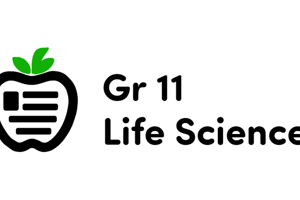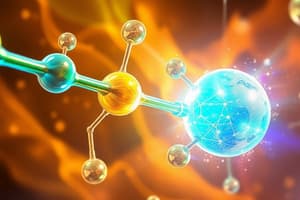Podcast
Questions and Answers
What do magnetic quantum numbers determine in an atomic orbital?
What do magnetic quantum numbers determine in an atomic orbital?
- The electron charge
- The size of the orbital
- The energy level
- The spatial orientation (correct)
Which statement is true regarding Lewis's electron dot diagrams?
Which statement is true regarding Lewis's electron dot diagrams?
- They only represent inner shell electrons.
- They illustrate electrons involved in chemical bonds.
- They display electrons in the outermost orbital only. (correct)
- They include all electrons in an atom.
Which of the following compounds are known to react to form a condensation polymer?
Which of the following compounds are known to react to form a condensation polymer?
- CH3COOH and C2H5NH2 (correct)
- HCl and NaOH
- C2H4 and H2O
- CO2 and CCl4
What characteristic of water allows it to be a versatile solvent?
What characteristic of water allows it to be a versatile solvent?
Which statement correctly describes polyester?
Which statement correctly describes polyester?
What is the electronic configuration that indicates an atom is diamagnetic?
What is the electronic configuration that indicates an atom is diamagnetic?
What does the octet rule explain regarding molecules?
What does the octet rule explain regarding molecules?
Which of these statements about carbohydrates is true?
Which of these statements about carbohydrates is true?
Which statement is correct about the geometric shape of CO2?
Which statement is correct about the geometric shape of CO2?
What property of water contributes to its ability to dissolve polar substances?
What property of water contributes to its ability to dissolve polar substances?
Which feature differentiates condensation polymerization from other types of polymerization?
Which feature differentiates condensation polymerization from other types of polymerization?
Which of the following statements is true regarding the bonding in Terylene and complex carbohydrates?
Which of the following statements is true regarding the bonding in Terylene and complex carbohydrates?
What is a key characteristic of diamagnetic materials?
What is a key characteristic of diamagnetic materials?
What type of molecule is CCl4, and what can be inferred about its polarity?
What type of molecule is CCl4, and what can be inferred about its polarity?
What is the relationship between ribose and deoxyribose in terms of their molecular function?
What is the relationship between ribose and deoxyribose in terms of their molecular function?
Why do condensation polymers like polyester require unsaturated hydrocarbons as monomers?
Why do condensation polymers like polyester require unsaturated hydrocarbons as monomers?
In the context of amino acids and protein synthesis, which of the following statements is accurate?
In the context of amino acids and protein synthesis, which of the following statements is accurate?
What effect does the distortion of a tetrahedral molecular shape have, as seen in ammonia?
What effect does the distortion of a tetrahedral molecular shape have, as seen in ammonia?
Flashcards
Magnetic Quantum Numbers
Magnetic Quantum Numbers
Values that describe the spatial orientation of atomic orbitals.
Lewis Dot Diagrams
Lewis Dot Diagrams
Represent atomistic valence electrons, which are crucial to chemical bonding.
Condensation Polymers
Condensation Polymers
Polymers formed by linking monomers through reactions that release a small molecule (usually water).
Polar Molecules
Polar Molecules
Signup and view all the flashcards
Polymerization
Polymerization
Signup and view all the flashcards
Alcohol General Formula
Alcohol General Formula
Signup and view all the flashcards
Diamagnetic Material
Diamagnetic Material
Signup and view all the flashcards
Octet Rule
Octet Rule
Signup and view all the flashcards
Nonpolar Covalent Molecule
Nonpolar Covalent Molecule
Signup and view all the flashcards
Monomer of Protein
Monomer of Protein
Signup and view all the flashcards
Spatial Orientation of Orbitals
Spatial Orientation of Orbitals
Signup and view all the flashcards
Lewis Dot Diagrams and Bonding
Lewis Dot Diagrams and Bonding
Signup and view all the flashcards
Hydrolysis of Condensation Polymers
Hydrolysis of Condensation Polymers
Signup and view all the flashcards
Polar vs. Nonpolar Molecules
Polar vs. Nonpolar Molecules
Signup and view all the flashcards
Water as a Solvent
Water as a Solvent
Signup and view all the flashcards
Condensation Polymerization
Condensation Polymerization
Signup and view all the flashcards
Trigonal Pyramidal Shape
Trigonal Pyramidal Shape
Signup and view all the flashcards
Octet Rule and Stability
Octet Rule and Stability
Signup and view all the flashcards
Dehydration Synthesis
Dehydration Synthesis
Signup and view all the flashcards
Study Notes
Chemical Bonding and Structure
- Magnetic quantum numbers determine the spatial orientation of atomic orbitals.
- Lewis electron dot diagrams show outermost orbital electrons.
- Polar molecules like water dissolve polar substances, nonpolar molecules dissolve with nonpolar.
- HCl is a polar molecule.
- Cohesion and polarity are water's solvent properties.
- Polymerization joins monomers.
- Condensation polymerization creates substances like polyester from unsaturated hydrocarbons.
- Trigonal pyramidal shapes can form with lone electron pairs.
- BF3 has less than an octet in its structure.
- Oxygen is diamagnetic.
- Some polymers are made of complex carbohydrates.
- Polyester softens at high temperatures due to strong carbon-carbon bonds.
- Amino acids are the monomers of proteins.
Molecular Properties
- Octet rules explain molecular stability.
- CCl4 is a nonpolar covalent molecule.
- Carbohydrates digest slowly.
- CO2 is nonpolar due to its symmetrical charge distribution and shape.
- Alcohol general formula is R-OH
- Ribose and deoxyribose are in RNA and DNA.
- Condensation polymerization involves loss of small molecules.
- Terylene and carbohydrates share similar monomer linkages.
- Hydrocarbon derivatives have higher boiling points than hydrocarbons.
- Dehydration synthesis joins molecules (e.g., proteins, lipids, carbohydrates, nucleic acids).
Studying That Suits You
Use AI to generate personalized quizzes and flashcards to suit your learning preferences.




